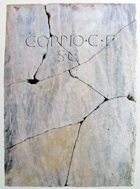

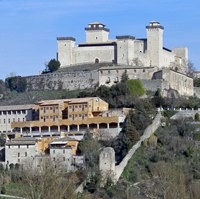
This site at the summit of Colle di Sant' Elia seems to have been occupied from a very early date (see below). It seems to have been the site of one or more Umbrian sanctuaries that were monumentalised after the foundation of the Roman colony.
Cardinal Gil Albornoz regained control of Spoleto for the papacy in 1354, but initially allowed the Perugians to maintain their dominance over it. However, there seems to have been an uprising against Perugian domination in the summer of 1359, and the Spoletans once more submitted formally to Albornoz, this time at Ancona (October 1359). Albornoz appointed his chaplain Enrico da Sessa, Bishop of Ascoli, to reform the statutes of the city. Even at this stage, the Perugian Podestà was retained. However, the Perugian fortress near Porta Fuga was demolished.
Albornoz appointed Ugolino da Montemarte as rector of the Duchy of Spoleto in 1360. He was documented in Spoleto in April 1360. He was present, together with Albornoz and Blasco Fernández de Belvis, at the provincial parliament held in Spoleto on April 22, 1361, at which (inter alia) a tax was imposed on the citizens of the city in order to finance the construction of the papal fortress (later known as the Rocca di Albornoz), necessitating the demolition of the church of Sant’ Elia (see the plan below). Work began on the project a year later.
-
✴In 1362, Cardinal Albornoz nominated Matteo di Giovannello, il Gattapone as “offitialeni et suprastantem fabbrice rocche”.
-
✴The first papal castellan, the Spaniard Pedro Consalvo, was appointed in 1367, a few months after Cardinal Albornoz died.
-
✴The last recorded payment to il Gattapone was made in 1370.
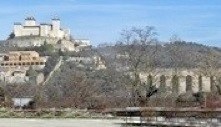
A series of popes took a close interest in the Rocca in the 15th and early 16th centuries:
-
✴Pope Nicholas V appointed his half brother, Cardinal Filippo Calandrini as castellan of the Rocca in 1447. Andreola Tomeo dei Bosi, the mother of both men, lived here from 1447 until her death in 1451. (Her tomb (1468) in the Duomo contains the arms of Cardinal Calandrini). Nicholas V stayed with his family in the Rocca in 1449 during an outbreak of plague in Rome. According to Giorgio Vasari, he employed Bernardo Rossellino, who made "within it dwellings so beautiful, so commodious and so well-conceived that nothing better could be seen".
-
✴Pope Pius II further restored the papal apartments during his stay in 1459.
-
✴Pope Sixtus IV appointed Domenico Gentile Riccio, the husband of his niece Violante as castellan in 1478. The tomb Bianca (died 1481), the daughter of Domenico Gentile and Violante, and that of Violante herself (died 1483), are in the Duomo.
-
✴Pope Alexander VI appointed his daughter, Lucrezia Borgia, a Governor of Spoleto in 1499-1502, during which time she lived in the Rocca.
-
✴Pope Leo X appointed Pietro di Nicolò Ridlofi as governor of Spoleto in the period 1514-6. He was the husband of Contessina dei Medici, the pope’s sister.
The Rocca lost its strategic importance from the 16th century. The Palazzo Apostolico was moved into the city in 1764 and the Rocca became simply a barracks. It was adapted for use as a prison in the 1817.
On 17th September, 1860, the Piedmontese troops of General Filippo Brignone took the Rocca. (Among the vastly out-numbered papal forces there was a contingent of 327 Irish volunteers led by Major Myles O'Reilly and Captain John Joseph Coppinger). Spoleto then became part of the new Kingdom of Italy.
Benito Mussolini used the prison at the Rocca for political prisoners. A brigade of partisans managed to arrange for a number of them to escape in October 1943 and they formed the nucleus of the local Anti-Facist resistance movement. An inscription near the entrance to the Rocca commemorates these events.
The prison, which reverted to civil use after the Second World War, was finally closed in 1982. The Rocca has recently been restored and part of it now houses the Museo Nazionale del Ducato di Spoleto.
Tour of the Rocca
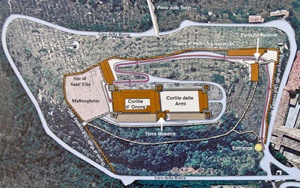
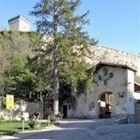
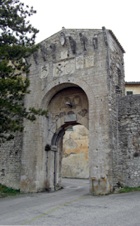
-
✴Pope Nicholas V and others above the upper arch on the front (illustrated);
-
✴Cardinal Albornoz and Pope Urban V above the lower arch on the front; and
-
✴Pope Alexander VI and Pope Julius II on the back.
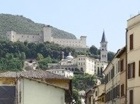
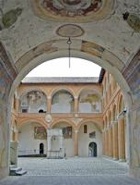
-
✴the Cortile delle Armi; and
-
✴the Cortile d' Onore (seen here from the Cortile delle Armi).
Cortile d' Onore
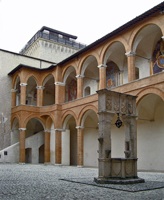
The Cortile d' Onore, at the heart of the residential part of the Rocca, has a two-storey loggia on three sides:
-
✴The rooms on the ground floor were mostly used for administrative purposes.
-
✴Those on the upper floor provided the residential quarters for visiting popes and papal governors.
The hexagonal well at the centre sits above a huge cistern and is decorated with the arms of Pope Nicholas V. It presumably belongs to the phase of restoration undertaken by Bernardo Rossellino.
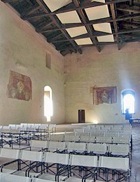
A door to the right leads to the Camera Pinta, inside the Torre Maestra (the tower in the picture above).
Cortile delle Armi
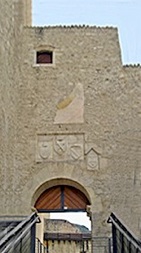

The arms above the main arch are those of Pope Urban V; Pope Nicholas V; and Cardinal Albornoz. [Arms to the right ??]
Art from the Rocca
A number of frescoes from the Rocca that are attributed to Giovanni di Pietro, lo Spagna are now in the Sala Lo Spagna of Palazzo Comunale.
Madonna and Child with saints (1514-5)
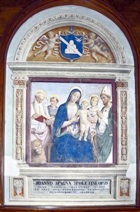
In 1799, Giovanni Turski, the commander of the Clitunno battalion of the army of the Roman Republic, arranged for the fresco to be detached and moved to Palazzo Comunale to protect it from his soldiers. The inscription that replaces the original predella attributes the work to lo Spagna and records its translation.
Three virtues (16th century)
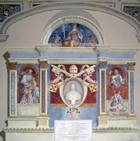
Archeological Finds from Colle di Sant' Elia
The following artefacts from the site of the Rocca, many of which were found during its restoration in 1983-6, are exhibited in the Museo Archeologico:
Pre-Roman Finds
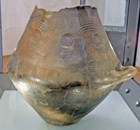
-
✴ceramic fragments that date from the middle of the Bronze Age (17th century BC) to the time of the Umbri (7th - 5th centuries BC);
-
✴a two-handled urn (11th century BC), which was found almost in tact in 2007, is decorated with the heads of birds [made of bronze ?] (illustrated here); and
-
✴a number of small bronze votive statues that provide evidence of one or more sanctuaries here that were in use in the 6th and 5th centuries BC.
Roman Temples
A number of artefacts found here suggest that this was the site of the Arx (acropolis) of the Roman colony:
-
✴A number of antefixes and clay votive offerings provide evidence of one or more temples that were in use in the 3rd and 2nd centuries BC.
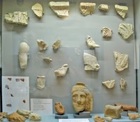
-
✴One of these fragments came from an antefix (3rd or 2nd century BC) representing “Potnia Theron” (Artemis as Mistress of the Animals), in which the goddess is flanked by rampant panthers.

-
✴A display in the museum describes an inscribed stone cippus that seems to date to the early decades of the Roman colony (i.e. late 3rd century BC). The Latin inscription reads “SATURNO SACRO” (sacred to Saturn ). The cippus was found embedded in the wall around the Rocca and would originally have been placed in the ground to mark the limit of the area dedicated to the God. It therefore seems likely that the colonists built a temple to Saturn on the lower slopes of Colle Sant' Elia.
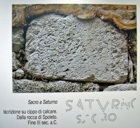
-
✴This inscription (1st century AD), which is on the base of a statue, commemorates Gaius Oppius, a friend of Julius Caesar. It is likely that this was one of a number of statues of famous men that were erected in front of the Roman temples here.
